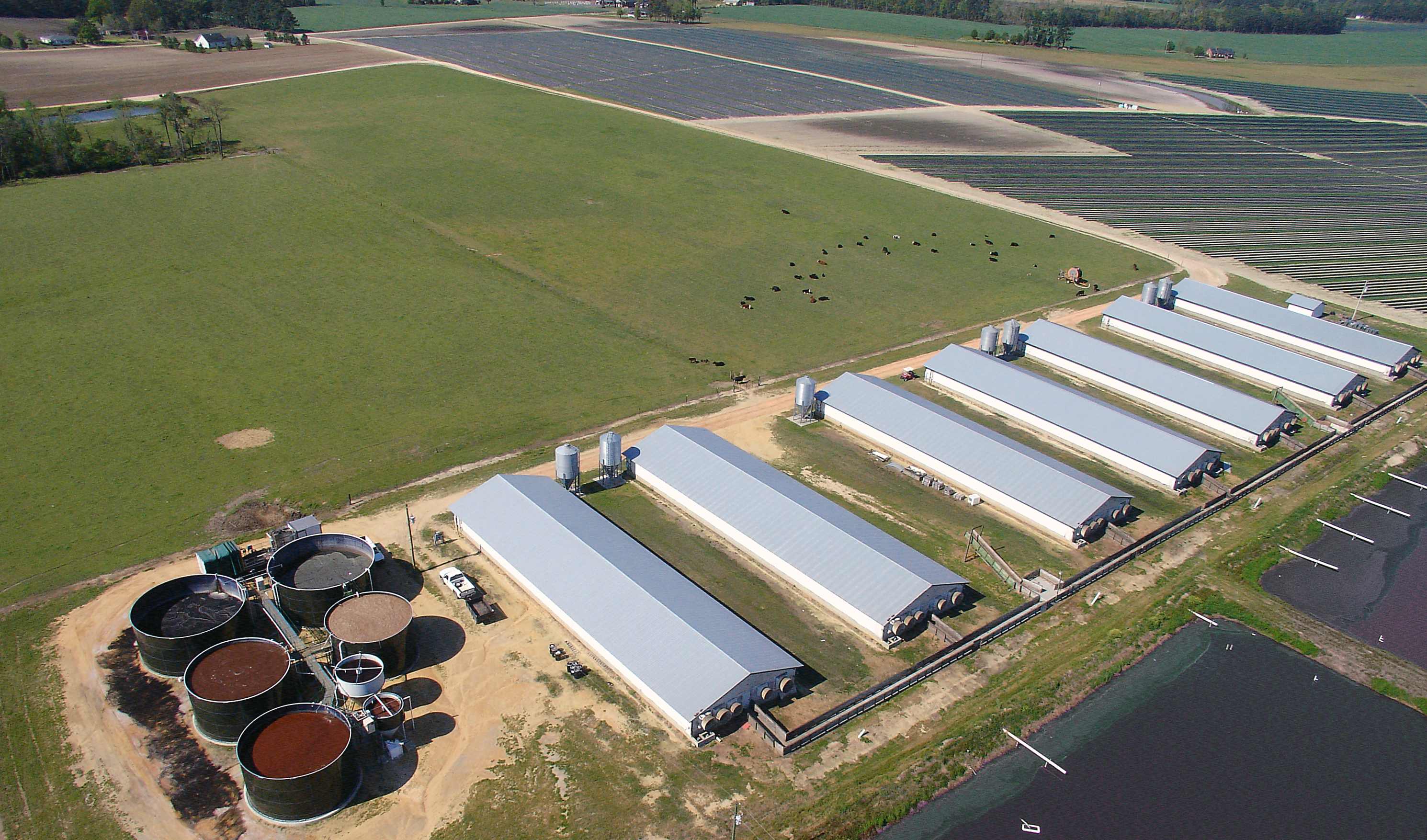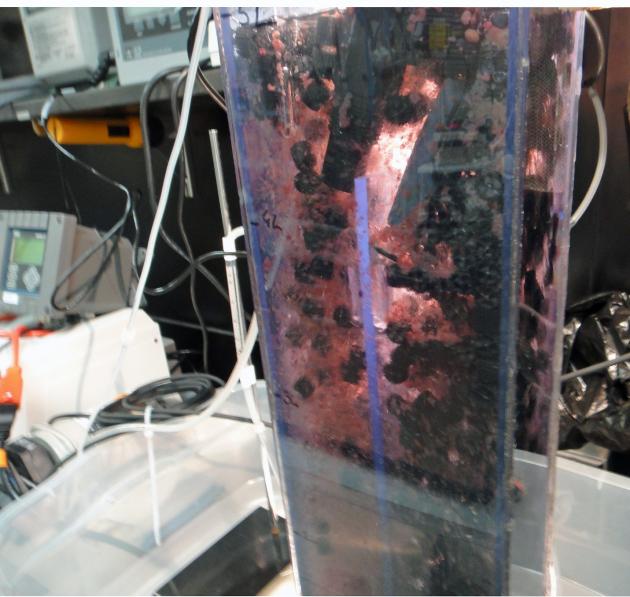![]() Waste to Worth home | More proceedings….
Waste to Worth home | More proceedings….
Why Study Ammonia Removal from Livestock Wastewater?
Biological nitrogen removal is regarded as the most efficient and economically feasible method available for removal of ammonia from wastewater. Its implementation in concentrated livestock farms can help reduce surplus nitrogen and ammonia emissions.
|
High performance nitrifying sludge (HPNS) is used to start-up biological ammonia removal treatment in swine manure treatment plants. Picture shows second generation project treating manure from 5,200-head finishing operation in Sampson County, NC. The system used solids separation, N removal and P removal processes. |
What Did We Do?
The effective use of biological nitrogen removal treatment in animal wastewater required development of new technologies and systems adapted to the higher-strength characteristics of liquid manure. These include: 1) development of a high performance nitrification bacterial mix; 2) systems that combine nitrification/denitrification with efficient liquid-solids separation; and 3) a new deammonification process using anammox bacteria for the removal of nitrogen in anaerobic digestion effluents.
What Have We Learned?
The discovery of a high-performing nitrifying bacterial sludge (HPNS) adapted to high ammonia concentrations (> 3,000 mg N/L) and low water temperatures (5 oC) significantly reduced biological nitrogen removal (BNR) plant footprint and costs. Nitrification/denitrification of fresh flushed manure was most effective after solid-liquid separation treatment, using a pre-denitrification configuration (Modified Ludzack-Ettinger or MLE process). The system is currently at its third generation. The third generation was demonstrated full-scale in 2012 in a farrow to finish swine operation that produced 30,500 hogs per year. It eliminated 99% of the ammonia contained in the manure effluent.
|
|
However, the implementation of nitrification/denitrification process in anaerobic digestion systems is a problem, since both the biogas production and denitrification require carbon. It would require about 30% less biogas production so that there is sufficient carbon for N removal through nitrification/denitrification. The discovery of a novel anammox bacteria in manure, Brocadia caroliniensis, is helping us address this problem effectively, especially after recent advances with a single-tank configuration. The new deammonification process we present here (partial nitritation and anammox) is a completely autotrophic nitrogen removal approach that eliminates the carbon needs for denitrification. Thus, it can be a promising approach for the biological removal of ammonia from anaerobic digester effluents that are low in carbon and high in ammonia concentration. We obtained rapid deammonification reaction by mixing nitrifying and anammox sludges in a single, aerated tank. The single-tank approach was tested with digested swine wastewater. Compared with traditional N removal, the deammonification process reduced 57% of the aeration and 100% of the carbon requirement. Therefore, deammonification is a key technology for development of more economical and energy efficient biological ammonia removal systems in the near future.
|
|
Future Plans
The nitrification/denitrification technology has been demonstrated full-scale and is at the commercialization phase. The single-tank deammonification has been pilot tested.
USDA has filed US patents for “high performance nitrifying sludge ” and “novel anammox bacterium isolate” (see reference list), and seeks commercial partners to bring deammonification technology to market. http://www.ars.usda.gov/business/docs.htm?docid=763&page=5
Authors
Matias Vanotti, USDA-ARS, Florence, South Carolina, matias.vanotti@ars.usda.gov
Matias Vanotti1*, Patrick Hunt1, José Martinez2, Airton Kunz3, Takao Fujii4, Ariel Szogi1, Kenji Furukawa5
1. USDA-ARS, Florence, South Carolina, USA
2. IRSTEA, Rennes, France
3. Embrapa Swine and Poultry, Concordia, SC, Brazil
4. Sojo University, Kumamoto, Japan
5. Kumamoto University, Japan
Additional Information
- Nitrification/Denitrification:
“Development of a Second Generation Treatment System for Management of Livestock Manure”, research update at https://acsess.onlinelibrary.wiley.com/doi/pdf/10.2134/asaspecpub67.c22
Vanotti, M.B., Szogi, A.A., Millner, P.D. and Loughrin, J.H. 2009b. Development of a second-generation environmentally superior technology for treatment of swine manure in the USA. Biores. Technol. 100(22):5406-5416.
Vanotti, M.B., A.A. Szogi, and T.F. Ducey. 2011. High performance nitrifying sludge for high ammonium concentration and low temperature wastewater treatment. US Patent Publication No. US2011/0000851 A1. US Patent and Trademark Office, Washington, DC.
- Anammox based Deammonification:
“Deammonification of Swine Wastewater Using Partial Nitritation and Anammox”, research update at USDA-ARS-CPSWPRC website : http://www.ars.usda.gov/Research/docs.htm?docid=22883#Anammox
Matias Vanotti, José Martinez, Takao Fujii, Ariel Szögi, Daisuke Hira. 2012. Ammonia Removal Using Nitrification and Anammox in a Single Reactor. In Proceedings 2012 ASABE Annual International Meeting, Dallas, Texas. July 29 – August 1, 2012. Paper No. 121337837.
Vanotti, M.B., A.A. Szogi, and M.J. Rothrock. 2011. Novel anammox bacterium isolate. US Patent Application No. 13/013,874. US Patent and Trademark Office, Washington, DC.
Acknowledgements
This research was part of USDA-ARS National Program 214 Agricultural and Industrial Byproducts, Research Project 6657-13630-005-00D “Innovative Bioresource Management Technologies for Enhanced Environmental Quality and Value optimization”.
The authors are solely responsible for the content of these proceedings. The technical information does not necessarily reflect the official position of the sponsoring agencies or institutions represented by planning committee members, and inclusion and distribution herein does not constitute an endorsement of views expressed by the same. Printed materials included herein are not refereed publications. Citations should appear as follows. EXAMPLE: Authors. 2013. Title of presentation. Waste to Worth: Spreading Science and Solutions. Denver, CO. April 1-5, 2013. URL of this page. Accessed on: today’s date.




